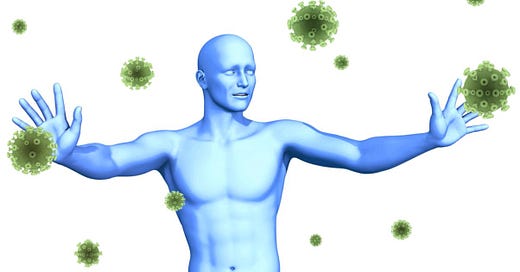Click the image to watch a text to video production or skip it and read the text below.
The human immune system is a marvel of biological engineering, designed to protect us from a vast array of potential threats, including viruses, bacteria, and even man-made bioweapons. God designed the human body to be able to do this from birth, and if we could not do this, we would not be able to survive as a species. At the heart of this defense system is the ability to recognize any foreign proteins that could ever exist, even ones those evil scientists haven’t thought of yet. The recognition is intelligent and comes from living cells. It does not come from unintelligent “lock and key” actions of antibodies that are nonliving proteins. Antibody actions are secondary, happening only AFTER the intelligent recognition has taken place.
This extraordinary capability is largely accomplished through a process known as VDJ recombination, which is crucial for the development of diverse and specific antigen receptors on B-cells and T-cells. VDJ recombination is a genetic mechanism that generates the diverse repertoire of antigen receptors necessary for the adaptive immune system to recognize a wide variety of pathogens. This process occurs during the early development of B-cells in the bone marrow and T-cells in the thymus gland.
For B-cells: VDJ recombination happens in the bone marrow. The process involves the seemingly random assembly of variable (V), diverse (D), and joining (J) gene segments to create the variable region of the B-cell receptor. Each B-cell ends up with a unique receptor that can recognize ONE specific antigen. So, each B-cell has thousands of receptors that are exactly the same for that B-cell, looking for only one specific protein antigen.
For T-cells: VDJ recombination takes place in the thymus gland. Like B-cells, T-cells rearrange their V, D, and J gene segments to form the T-cell receptor. Each T-cell has thousands of receptors that are exactly the same for that T-cell, looking for one protein antigen.
There are billions of T-cells and billions of B-cells, but they are not all unique. There will be a handful of these cells that are the same and are looking for the same unique protein.
Although the VDJ recombination for B-cells and T-cells are similar, the way they identify the proteins they are looking for are completely different. B-cells can detect free floating soluble proteins, or something that was injected in a product called a vaccine. But T-cells cannot do that. T-cells can only recognize proteins that are presented to them by APCs or antigen presenting cells like dendritic cells and macrophages.
This creates a huge problem for vaccines, because if the vaccine contains or makes too many antigens, B-cells can directly detect them and start making suboptimal antibodies to whatever was injected.
Conversely, in natural infections, antigen presenting cells will present smaller protein pieces of the foreign invader to T-cells on major histocompatibility type 2 sites, and those activated T-cells will help B-cells make more refined antibodies against all parts of the invader, not just a piece of it. This makes immunity from a natural infection far superior to any immune response to something that was injected.
The VDJ recombination process is highly complex and allows for the generation of billions of unique B-cell receptors and T-cell receptors. This diversity is essential because only a small subset of these receptors will match any given pathogen. When a pathogen invades, only a handful of B-cells or T-cells, out of the billions produced, will have receptors that can bind to the specific antigens presented by the pathogen. It sounds impossible, but this seemingly improbable matching process works effectively, providing robust protection against a wide array of threats, so there is no need to be afraid of the threats.
It is important to understand that it is the living immune cells—B-cells and T-cells—that actively patrol the body and eliminate infections. Antibodies, which are produced by B-cells, serve only as markers that bind to antigens. They do not destroy pathogens directly but flag them for destruction by other immune cells. The intelligence and adaptability of living immune cells are what make the immune system so effective. These cells can recognize, remember, and respond to specific pathogens, ensuring long-term immunity.
Despite its robustness, the immune system can be compromised by certain medical interventions. Treatments such as chemotherapy and radiation therapy can damage the bone marrow and thymus, where VDJ recombination occurs, thereby reducing the production of new B-cells and T-cells and impairing immune function. Immunosuppressive drugs, used in conditions like autoimmune diseases or organ transplants, can also inhibit the proliferation and differentiation of lymphocytes, indirectly affecting VDJ recombination. Genetic disorders such as Severe Combined Immunodeficiency (SCID) result from mutations in genes essential for VDJ recombination, leading to a lack of functional B-cells and T-cells. And if we’re not careful, the injection of mRNA gene therapies could end up negatively affecting VDJ recombination.
The human immune system's ability to recognize any foreign protein is critical for our survival. VDJ recombination plays a pivotal role in generating diverse and specific receptors on B-cells and T-cells, allowing the immune system to mount an effective response against a vast array of pathogens. Despite the complexity and seeming improbability of this system, it functions remarkably well, protecting us from countless threats. However, it is important to be aware of medical interventions that can weaken this capability, highlighting the need for careful management of treatments that impact the immune system, especially when it comes to shots called vaccines.
Thanks for reading, and thanks for staying smart.



indeed, thank you! such a valuable article!
thank you for explaining the system in plain English !